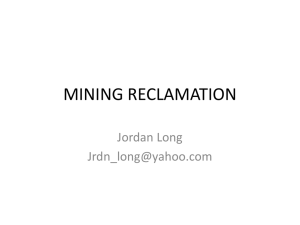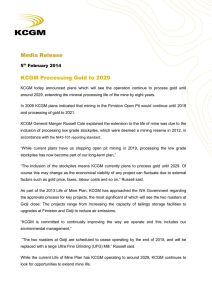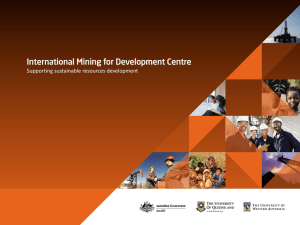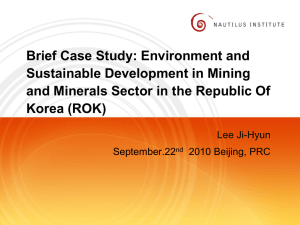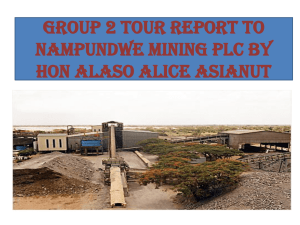Basics of SMCRA Title IV
advertisement
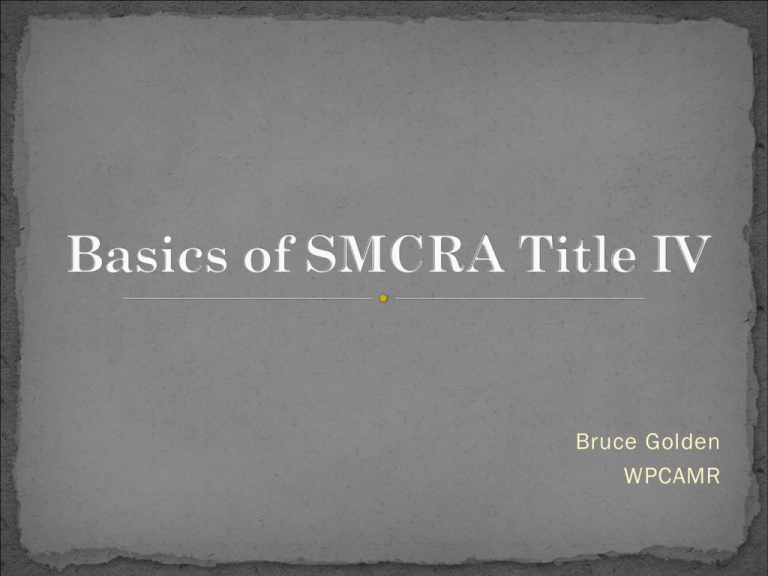
Bruce Golden WPCAMR Surface Mining Control & Reclamation Act Federal legislation regulating surface coal mining First enacted 1977 Latest amendments December 2006 SMCRA Title V deals with regulation of active surface mining post 1977 SMCRA Title IV addresses problems associated with the poor coal mining practices occurring prior to 1977 Source of Funds Per ton reclamation fee on every ton of coal mined in U.S. Now $0.35/ton surface mined, $0.15/ton deep mined Decrease 10% starting Oct 2007 ($0.315 & $0.135) Decrease another 10% in Oct 2012 ($0.28 & $0.12) Reclamation fees collected through 2021, then cease Funds deposited in Abandoned Mine Reclamation Fund Previous funds held back by Congress ($1.7 Billion) also reside in AMRF Funds from fees distributed to states as annual grants Federal Office of Surface Mining (OSM) administers AMRF and SMCRA program A formula determines each state’s annual grant Funds from the previous year’s fee collections are used Factors include a state’s current coal production level and the state “historic” production level Distribution of funding is now mandatory not subject to the appropriations process by Congress Amended legislation does a much better job of placing funding where the problems are. For next 7 years, amounts due from past unappropriated funds also paid out in equal installments (from Treasury). States receive annual grants until “certified” Last payout using previous year’s fees is in 2022 (since fee collection will be phased out in 2021) Thereafter, annual grants will be awarded at the 2022 level while remaining funds in AMRF are drawn down. ~$1.4 Billion over 15 years paid by per ton fees 7 yr 5balance yr payout ramp AMRF funds 1. Priority 1 & 2 Health and Safety Problems 2. Abandoned Mine Drainage Set Aside Program 3. Restoration of Drinking Water Supplies 4. State Administrative Overhead Historically, the main stream of Title IV funding Priority 1 problems represent “extreme” danger. Projects are more likely to be P1’s if close to populated areas Generally land-based hazards, including: open mine shafts and portals, dangerous highwalls (man- made cliffs), open pits, mine fires, unstable waste piles, abandoned buildings and equipment, subsidence. Abandoned Mine Drainage (AMD) projects are waste also eligible dangerous unstable highwalls open abandoned mine mine fires shafts open mine portal under this category if “adjacent” to asubsidence P1 or P2pits site & piles open buildings and AMD is promoted from a P3 to a P2 in this situation equipment Doesn’t count against AMD Set Aside program For a project to be eligible, it must be formally listed on the AMLIS inventory as maintained by OSM Pennsylvania’s inventory is estimated $1.1 billion Mike Hewitt hasat a great Inventory of P1 and P2 interactive problems was developed GIS mapping toolmainly in the 1980’s called RAMLIS. The inventory as it stands today is not up-to-date it you by can explore mining Some sites have been With reclaimed industry features state-wide. Some AMR sites were missed The status of some sites have changed yet, it’s free! 1980’s cost estimatesBetter are still listed Staygood?? for his excellent Is the $1.1 billion estimate Who knows! presentation! This may be an area where watershed groups may assist by helping to provide updates. Up to 30% of a state’s annual grant can be set aside to exclusively address AMD problems The state makes its request annually Any percentage up to 30% may be requested The funds are placed in a special state-controlled account to be used exclusively for AMD projects These funds may accrue interest No time limit on how quickly the funds are used Possible to use a portion for OM&R The AMD set aside diminishes the ability of doing P1 & P2 projects, at least in the short run but maybe not in the long run… more on that when discussing “certification” Any portion of a state’s annual grant can be used to restore drinking water supplies The water supply damage had to be substantially as a result of mining occurring before 1977 Some states will take full advantage of this provision This diminishes the ability of doing P1 & P2 projects, at least in the short run but maybe not in the long run… more on that when discussing “certification” The costs required to run the state program PA DEP’s Bureau of Abandoned Mine Reclamation (BAMR) is almost fully funded by Title IV Central Office Harrisburg Western PA bituminous Ebensburg Eastern PA anthracite Pottsville This is to certify that Pennsylvania has completed reclamation of all Priority 1 & 2 sites A state becomes “certified” when all the inventoried P1 and P2 sites have been reclaimed. States receive annual grants until certification. Title IV funding stops when a state certifies. Advantages of certification: All P1 & P2 sites will finally be reclaimed “One less government program to contend with” Disadvantage Title IV funding for non-P1 & P2 projects ends too. The amount of money a state spends on non-P1 & P2 projects only affects the number of years it takes to certify. Spending funds on anything other than P1’s and P2’s will : delay certification increase the total funds coming into the state Editorial note: To maximize funds coming to a state, delay certification Taking a full 30% set-aside annually effectively does this “Stay in the game” as long as there’s available funds If a state has not certified by the end off 2022, it may continue to receive annual state grants at the 2022 level using remaining AMRF balance until the state certifies, or money in AMRF runs out, whichever comes first. The AMRF currently has a fund balance of ~$1.7 billion Until 2022 the only net draw-down of the AMRF will be by OSM to make up administrative shortfalls Over $1 billion will likely be available for states Multiple states delaying certification makes predicting how long the AMRF funding will last quite difficult. Effect of other states not certifying AMRF funds PA will receive 3-4 times more Title IV reclamation funding over the next 15-20 years Will significantly speed up reclamation efforts A 5 year ramp-up period several years before a significant increase in annual funding occurs Greater flexibility to address mix of problems AMD can have a much larger emphasis than before Up to 30% set-aside New “adjacent” provision Over the next 15 years, Pennsylvania will receive an estimated $1.4 Billion for abandoned mine reclamation and perhaps another $500 million after that. This once-in-a-lifetime windfall will cut decades from the time needed to reclaim scarred landscapes and water polluted by antiquated mining practices. Pennsylvania has as much as $15 Billion worth of abandoned mine problems. While the new funding is very significant, we have to weigh it against the overall magnitude of the problem. Simply put, we have far more problems than resources to fix them. This unique opportunity should be managed to make the most of the benefits of this significant, yet limited resource. ☻ ☻ ☻ ☻ ☻ ☻ ☻ http://wpcamr.org http://amlcampaign.wpcamr.org http://www.depweb.state.pa.us/abandonedminerec http://amp.wpcamr.org http://2007.treatminewater.com http://AMRClearingHouse.org http://www.orangewaternetwork.org FIN


